
THE CHILDREN of Walter and Dagmar Siegenthaler, owners of the Park in the ‘50s and ‘60s, are pictured with current owners of the Park site, Ben and Helen Zoss. Left to right: Karen (Siegenthaler) Crisco, Richard Siegenthaler and Helen and Ben Zoss.
Forty-six years after the last pair of feet jitterbugged across the well-worn maple floor of the dance hall down by the Jim, those who still hold the memories dear gathered near the river Saturday to commemorate and celebrate the famed playground of their youth.
Ruskin Park has now been reduced to a collection of what once was. Little remains of the structures, dilapidated far beyond repair, taken back by nature, yet the legend of this entertainment mecca will not be forgotten.
Interest in replacing the historic marker, originally placed on the north side of Highway 34 across from the road leading down to the park, was sparked after a Ruskin Park Facebook page was started up. Interest increased, memories were shared and photos added, many by former Forestburg resident Joe Tlustos.
After the question was posed of where the sign had disappeared to, another former Forestburg resident Vic Zimmerman, who only had the chance to visit the park one time, headed up a fundraising effort to replace the marker.
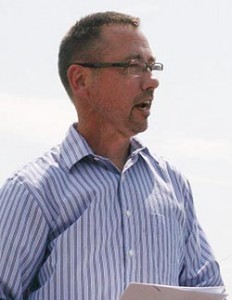
VIC ZIMMERMAN played an integral part in bringing the historical marker back to Forestburg. He spoke at the dedication ceremony giving a brief history of the Park and recognizing relation of Park owners and those who donated to the sign fund.
By the time the sign was purchased earlier this year, around 60 people had donated to the Ruskin Park sign fund. The sign was purchased and plans were made for the unveiling and a dedication to be held the afternoon of the annual Forestburg Alumni Banquet. The new sign was placed on the south side of Highway 34 at the entrance to the half-mile road down to the old site of the Park on the river bottom.
As the sign says, “Ruskin Park was synonymous with excitement, entertainment and romance since its inception.” After traveling from afar, across treeless plains, settlers were enchanted by the grove of trees at a place William G. Santee dubbed Forestburgh, on the south side of what would become Ruskin Park.
Six years later, by 1880, Forestburg had been moved to the east side of the James River, the “h” had been dropped and a full-fledged town had begun to take shape. It wasn’t long however, when the Chicago, Milwaukee & St. Paul Railway Co. announced plans to run their tracks across the river two miles north. Forestburg picked up again and moved.
Yet, settlers remained enamored of the original grove of trees to the south. Among those were Hiram Augustus Rodee and his family, who arrived at the site in 188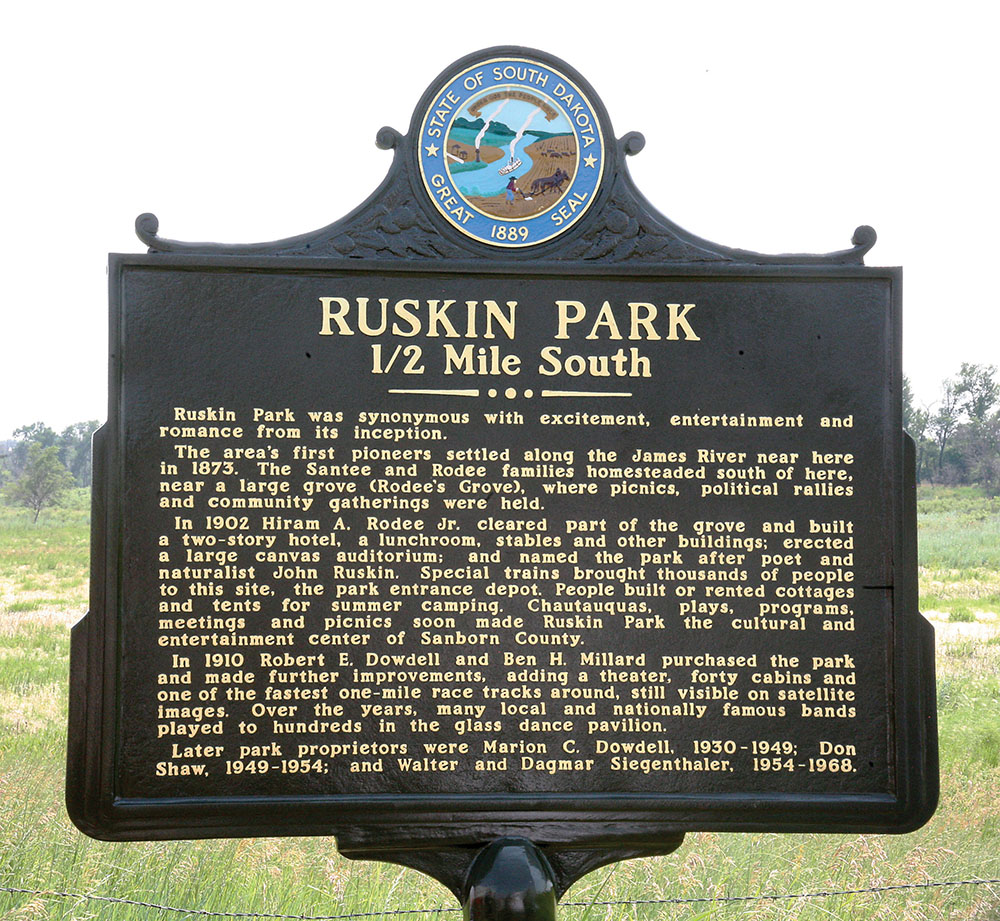 2. Over time Hiram Rodee acquired nearly 1,900 acres on and near the James River and the beloved grove of trees became known as Rodee’s Grove.
2. Over time Hiram Rodee acquired nearly 1,900 acres on and near the James River and the beloved grove of trees became known as Rodee’s Grove.
Rodee sent his son, Hiram Augustus “Gus” Rodee, Jr. back east to New York for school in the late 1890s. While he was in the town of Chautauqua, N.Y., Gus became inspired to bring Chautauqua back with him to the natural beauty his father had found on the Jim.
Chautauqua was an adult education movement started in Chautauqua, N.Y. in the late 1800s. The idea was to bring speakers, performers, musicians, preachers, etc. to communities that otherwise would have little opportunity for entertainment and culture. Chautauqua filled a void in the lives of rural Americans well before the information highway was built. The movement caught on, spread throughout the country and remained popular until the 1920s.
Gus returned to the grove in 1902 and ordered construction of a two-story hotel, stables, workshops, a lunchroom, workers’ quarters and a half-mile oval racetrack for horse races. Two artesian wells were dug and an “auditorium” (a large canvas tent) was put up, with a stage and room for several hundred people.
Named after poet and naturalist John Ruskin, of whom Gus was an admirer, Ruskin Park had been born.
To help finance the development, Gus sold lots to nearby residents who built summer homes. Allens, Brisbines, Dowdells and Bennetts were among those first summer residents.
The Railway Co. cooperated with Gus’ plan by offering special excursion rates to Ruskin Park. The railroad allowed him to build a depot located at the entrance of the park and carriages met the train to bring visitors into the Park for 10¢ each way.
The first Chautauqua held in Sanborn County was July 2, 3 and 4, 1904 at Ruskin Park. The program had something for everyone, with music from the State World’s Fair Band, an address by former U.S. Senator Richard F. Pettigrew, a Woonsocket versus Artesian basketball game, more music, addresses and orations. Cost was 15¢ for kids and 25¢ for adults or season passes were sold for 25 and 50 cents.
The 1904 season saw another big event with the Harvest Picnic on Aug. 17. The all-day event boasted music entertainment and a baseball game between Woonsocket and Artesian.
The next years Ruskin Park would host a Chautauqua and Harvest Festival each year, a Sanborn County Democratic Rally and Old Settler’s Picnic. The Park gained regular telephone service and fresh groceries were delivered daily.
In 1909 Hiram Rodee, Sr. became ill and he and his wife returned to New York. Hiram had wanted to sell the 2,000-acre estate, so Gus honored his father’s wishes and returned to New York with him.
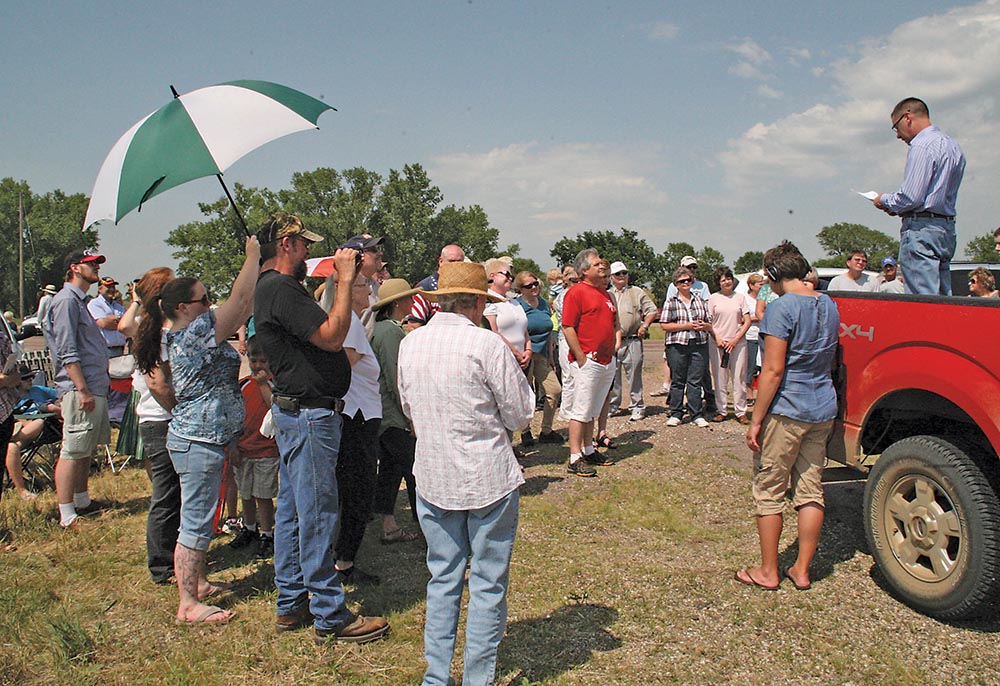
A CROWD of around 50-75 people attended the dedication of the Ruskin Park historical marker, including a number of relatives and descendants of former Park owners.
One of the people who had bought a lot and built a summer home was “Sanborn County Advocate” editor Robert Dowdell. He and Ben H. Millard, owner of the Artesian State Bank, purchased the entire Rodee ranch. They divided the ranch into smaller farms and sold them off, providing working capital to further develop Ruskin Park.
When they learned the St. Louis (Lewis & Clark) Exposition was being demolished, and auctioned off they traveled there and purchased a load of heavy, tall glass doors. They used the doors for the outside walls of a new dance pavilion. The pavilion, with its “prism glass” walls rose 40 feet to the apex, had a maple floor and was gas lighted. The partners contracted an orchestra to stay on continuously, and Ruskin Park’s dance era was born.
Dowdell and Millard also added a theater, 40 cabins for rentals and improved the racetrack so it could be used for auto races as well as horse races. A ballpark was also put in the middle of the racetrack.
1910 was the first season under the new ownership and through the teens, the Park became the place to go for entertainment in Sanborn County. Picnics, baseball games, speakers, bands, concerts, races and water sports were among the events and entertainment provided under Dowdell and Millard’s tenure.
In 1915, after improvements to the racetrack were made a 50-mile auto race was scheduled for July 3 and 5 with a $500 prize for the winners. A 25-mile motorcycle race was also held with a $100 prize.
In August of 1919, the State Carnival of Sports was held in honor of World War I veterans, who enjoyed free admission that day. The event featured the Donaldson Brothers Flying Circus complete with three Army biplanes with rapid fire machine guns performing acrobatic stunts, loop the loops, formation flying and spiral drops. Auto races, a baseball game, a barbecue, band music and dancing were all part of the day’s festivities.
The Roaring Twenties saw changes in society and advances in travel and left Ruskin Park to settle into hosting mostly local events such as county picnics, political meetings, Fourth of July celebrations and the weekly crowd at the dance pavilion. Bands such as Lawrence Welk were favorites of the time, playing at events named the “Garden Dance”, “Harvest Moon Dance” and “Hunters Ball.”
The ‘20s were when writer Tom Barkdull described Ruskin Park as “The Playground of the Prairie,” and racecar driver Eddie Rickenbacker allegedly remarked that the Ruskin Park racetrack was the fastest dirt track he had ever driven.
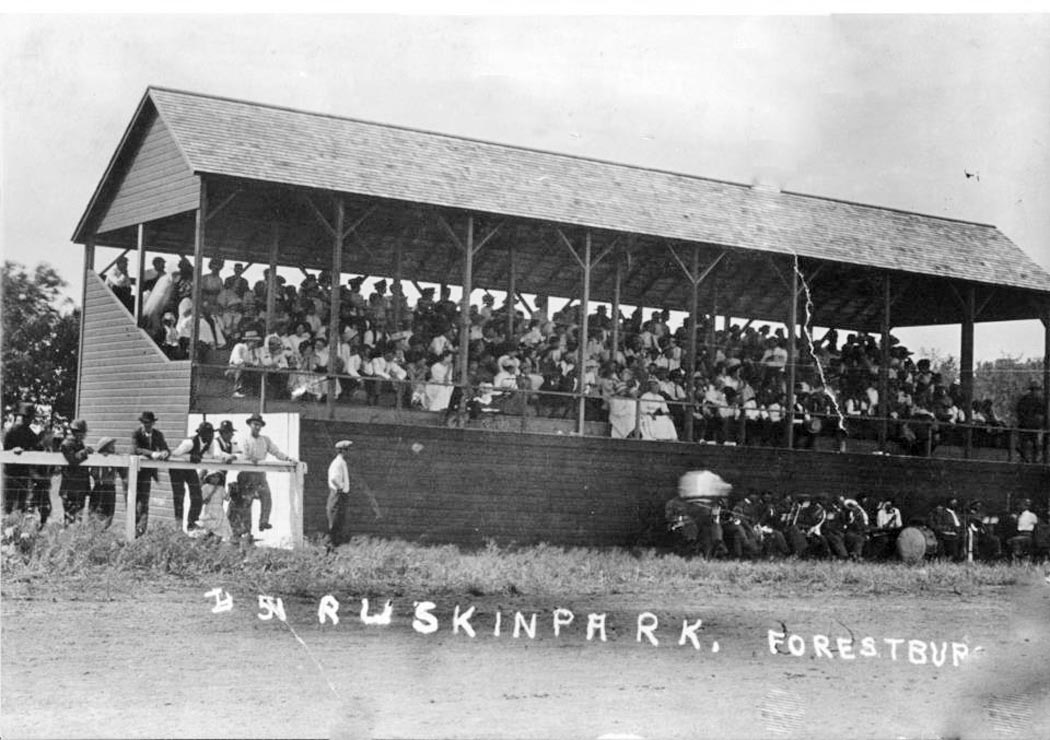
THE GRANDSTAND at the Ruskin Park racetrack and ballpark was packed on many an occasion, watching everything from horse, car and motorcycle races to local baseball teams battling it out.
Ownership was passed to Marion Dowdell in 1930. Even though the “roaring” was over, people still came to Ruskin Park in the ‘30s, likely as an escape from their dusty realities.
More than 200 guests attended the Sanborn County Pioneer Association picnic in 1932. The Fourth of July celebration remained the important event of the year, but by 1934 had been cut down to just one day.
It was the Dirty ‘30s and times were hard, and Ruskin Park shined a light on an otherwise tough existence. July 4th celebrations boasted such activities as a rodeo, a menagerie of rattlesnakes, coyotes and prairie dogs and a tug-of-war across the river with a half-barrel of beer in the middle of the rope as a prize for the winners.
Marion Dowdell added a 21-hole golf course to the property and the first tournament was held July 17, 1932. The rest of the ‘30s saw the Park hosting organizations’ picnics, a school sports day and 4-H rallies.
Emphasis in the 1940s was placed upon dancing, rollerskating, banquets, picnics and rallies. The Park continued to host the Old Settlers Picnic, 4-H banquets and of course, a Fourth of July celebration.
In June of 1949, Ruskin Park was sold to bandleader Don Shaw. Shaw returned to his band after the 1950 season and at the start of the 1951, season ownership had again been passed to Walter and Dagmar Siegenthaler.
The rock ‘n roll era would move into the county in the ‘50s and played a large part in reviving Ruskin Park. It became known as a major dance hall in the state and would, 60 years later in 2010, be recognized as such when it was chosen to be inducted into the South Dakota Rock ‘n Roll Hall of Fame.
The Siegenthalers began holding dances every Thursday and Saturday night. Dagmar was quoted some time later:
“Our children were pretty young when we put them to work. Richard was at the popcorn stand and Karen waited on the counter in the café. We also hired two policemen…. We didn’t allow people in unless they were dressed up – we thought they would act better.”
Sundays in the ‘50s were for rollerskating and in the spring the Park hosted school picnics. Ruskin Park may have also been the start of pheasant tourism in the area, as Dagmar recalled they would book hunters from other states to hunt pheasants in the fall.
In September of 1956 the state Republican Party opened their campaign at Ruskin Park. Governor Joe Foss was the guest speaker for a crowd of approximately 250.
On May 7, 1959 Ruskin Park made headlines with Myron Lee and the Caddies, the first band of national prominence to play there for a number of years. Later on that year Jerry Lee Lewis also appeared.
The age of rock ‘n roll was here to stay and the 1960s at Ruskin Park echoed that sentiment. Thursday night dances were rocking with moves such as the twist, even featuring the New York band The Twisters, while Saturday nights were reserved for old- time music.
The Everly Brothers appeared at the Park in July of 1962, followed by Conway Twitty and the Velairs later that same summer.
The decline of Ruskin Park began in 1963, with competition popping up all around the area: The Rainbow Ballroom in Lane, the Loomis Club in Loomis, Twin Lakes and the Kongo in Mitchell.
Walter Siegenthaler died of a heart attack in 1967, and the already crippled Ruskin Park was doomed. Merlin Jacoby purchased the park and buildings. The pavilion was converted into a haymow and machine shed, the cabins were used for storage and granaries. The remainder of Ruskin Park, furniture, rollerskates, booths, etc., was auctioned off in 1968.
Carlton Cassens purchased the property in 1985 and held onto it until his death in February of 2003. Ben and Helen Zoss of Forestburg currently own the property and graciously donated the space of land at the entrance so that the millions of memories Ruskin Park holds may, in some small way, be immortalized.
The Ruskin Park historic marker can be found east of Forestburg on the south side of Highway 34 just past the James River.

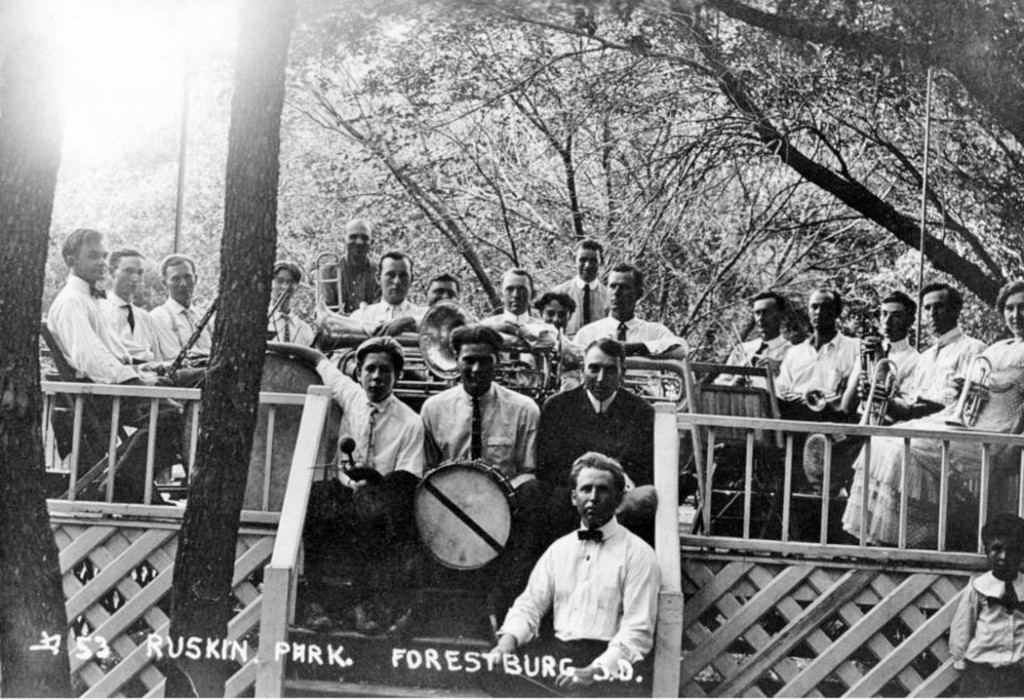
Tweet